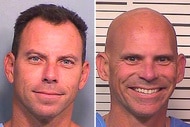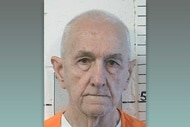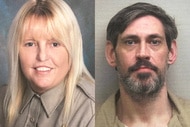Create a free profile to get unlimited access to exclusive videos, breaking news, sweepstakes, and more!
Who Is Dr. Barbara Rae-Venter And How Did She Help Catch The Golden State Killer Suspect?
Retired Contra Costa County District Attorney’s Office investigator Paul Holes celebrated her publicly on Twitter last week.

Paul Holes, the recently retired Contra Costa County District Attorney’s Office investigator who followed the Golden State Killer case for decades, released last week the name of a woman who played a crucial role in breaking the case.
“The genetic genealogist who helped find #GSK Deangelo has given me permission to divulge her name - Barbara Rae-Venter,” Holes tweeted on Wednesday. “Without Barbara's help we would probably still be building family trees. She gave us structure and her expertise was invaluable.”
In April, former police officer Joseph DeAngelo, 72, was arrested after he was identified as the prime suspect behind the infamous crime spree that spanned six California jurisdictions between 1975 and 1986. Last week he was formally charged with 13 counts of murder, 18 rape and rape special circumstances charges, six firearm charges, 13 kidnapping for purposes of robbery charges, and 21 use of a weapon charges. However, police believe he raped and robbed dozens more.
So, who is Rae-Venter and what did she do?
1. She’s a retired intellectual property attorney and scientist
Rae-Venter, 70, is a retired intellectual property attorney who lives in Northern California. According to her practice’s website, she specialized in the “prosecution of patent applications in all aspects of biotechnology, and particularly in the areas of biochemistry, cell and molecular biology, biopharmaceutics and agricultural biotechnology.”
She received her Ph.D. in biology from the University of California, San Diego in 1976. Decades ago, she taught biochemistry and endocrinology and she worked as a research scientist who studied determinants of breast cancer and cancers of the gastrointestinal tract.
Her ex-husband is Craig Venter, a biotechnologist and geneticist known for being involved with sequencing the second human genome. He's the founder of the J. Craig Venter Institute, a nonprofit genomic research institute dedicated to advances in human health.
2. She’s a genetic genealogistOriginally from New Zealand, she’s been conducting extensive research on her own family history for a decade using primarily online tools, according to DNAAdoption.
“Barbara set up and administers the Normanites DNA Project on Family Tree DNA for people whose ancestors or their relatives were followers of the Reverend Norman McLeod,” the site notes. “The Reverend led his flock from Sutherlandshire, Scotland to Pictou and St. Ann's, Nova Scotia, Canada and three decades later to Adelaide, Australia and Waipu, New Zealand.”
3. Holes hand-picked her to help, and she did it all for free
Holes reached out to her for her expertise in the Golden State Killer cold case.
“Her expertise proved to be invaluable,” Holes told Mercury News in San Jose, California. “And when she was doing it, she was volunteering her time, and it just really speaks to her as a person.”
4. She’s an angel
She does volunteer work as a “search angel” for DNA Adoption, a nonprofit that shows adoptees how to use DNA to track down their birth parents.
She also volunteers her services at the Monterey Family History Center, according to DNA Adoption.
5. She’s solved murders before
In March 2015, a San Bernardino County detective asked Rae-Venter for help in an unsolved case. Police were looking into the abuse of a little girl named Lisa who who was abandoned in 1986 by a drifter who had claimed to be her father. The man, who went by several names, including Larry Vanner, pleaded no contest to murdering his live-in girlfriend Eunsoon Jun in 2003 and he died in prison in 2010, taking to the grave the truth of his real relationship with Lisa. By 2015, Lisa was an adult and a DNA test had shown Vanner wasn't her biological father. That left the identity and fate of her true parents a mystery.
Rae-Venter told Forensic Magazine in 2015 that she combed through several online databases looking for genetic clues by using some of Lisa's DNA. Upon Rae-Venter’s advice, Lisa submitted a DNA sample to each of the three genomics testing companies. After piecing together information from genetic relatives, Rae-Venter and authorities discovered Lisa was actually Dawn Beaudin, who disappeared as an infant, along with her mother Denise and her boyfriend Robert Evans, from New Hampshire in 1981. Futher investigation helped determine that Vanner’s DNA could be linked to the unsolved “Bear Brook Murders," which took place near where Dawn Beaudin and her family were last seen, according to Mercury News. In that horrific case, a woman and three young girls were killed, stuffed into metal drums and buried in New Hampshire’s Bear Brook State Park. The victims were killed sometime between 1977 and 1985 and had never been identified. Piecing together information from both California and New Hampshire, authorities concluded Larry Vanner and Roger Evans were actually the same person, and that he was responsible for the "Bear Brook Murders."
It was this work, that caught Holes’ attention.
6. She brought structure to the Golden State Killer investigation
“She came in and was like, ‘No, no, no, you need to do it this way,’” Holes told Mercury News. “She gave us structure.”
As Rae-Venter and the team narrowed down their search to a few suspects, she began to notice that the suspect’s description could mean he has Italian heritage.
“At one point she said, ‘This guy looks like he has a fair amount of Italian in him and we’re like, ‘What?!’ ” Holes told Mercury News. “Nowhere had any witness accounts mentioned Italian, but when the name DeAngelo came up, we thought maybe Barbara was on to something.”
7. She never met Holes, or any of the investigators in person
From her home, she created dozens of family trees along with the rest of the investigative team based on police information about the crime spree and physical attributes from the killers’ DNA left at crime scenes.
It was all digital.
8. She’s working on more cold cases. Could she solve the “Boy in the Box” case?
“I have quite a number of cases […] in progress,” Rae-Venter told Mercury News. “I’m hoping to get results as early as next week.”
One such case is the 1957 cold case dubbed “Boy in the Box,” where an unidentified boy was found killed and left inside a cardboard box in Philadelphia.
[Photos: AP, Getty Images]























